Sourdough Croissants
This post may contain affiliate links. As an Amazon Associate, I earn from qualifying purchases. Please read my disclosure.These homemade sourdough croissants are better than the bakery ones! They are fresh, light, and flaky with a glossy golden brown coating. Level up your breakfast or add an extra flare to sandwiches with this easy recipe that the whole family will love!

Making croissants with sourdough starter adds a delicious depth and complexity in flavor and eliminates the need for added commercial yeast. (Pro tip: If you don’t feel like making your own starter, ask around. You will likely find a friend who can gift you some of theirs!)
Your first time making these might feel challenging and overwhelming, but I assure you they are much easier than you think! With only 2 hours total of prep time, 30 minutes of cook time, and some patience during rest times, you’ll have warm croissants ready to eat!
As a lover of breads and pastries, I knew I wanted to make easy sourdough starter croissants that matched the best of the best in the bakery world. For me, the perfect croissant has 3 criteria: delicious buttery taste, flaky outside, and soft and airy inside.
This butter croissant recipe checks all those boxes, and more!
When you take a bite of these delicious sourdough croissants, you will feel like you are sitting outside of a French bakery. They really are that good!
Pair with your favorite coffee or tea, or use as a bread replacement in a tasty sandwich like this kale and caramelized onion panini.
👩🏽🍳 Why This Recipe Works
- No yeast needed
- Perfect for breakfast or lunch
- Prebiotic for gut health
- Delicious sour, tangy flavor
- Light and fluffy texture
- Best sourdough croissant recipe ever!
Latest Recipe Video!
🥘 Ingredients
Flaky sourdough croissants only require a few simple ingredients that are all pantry staples!
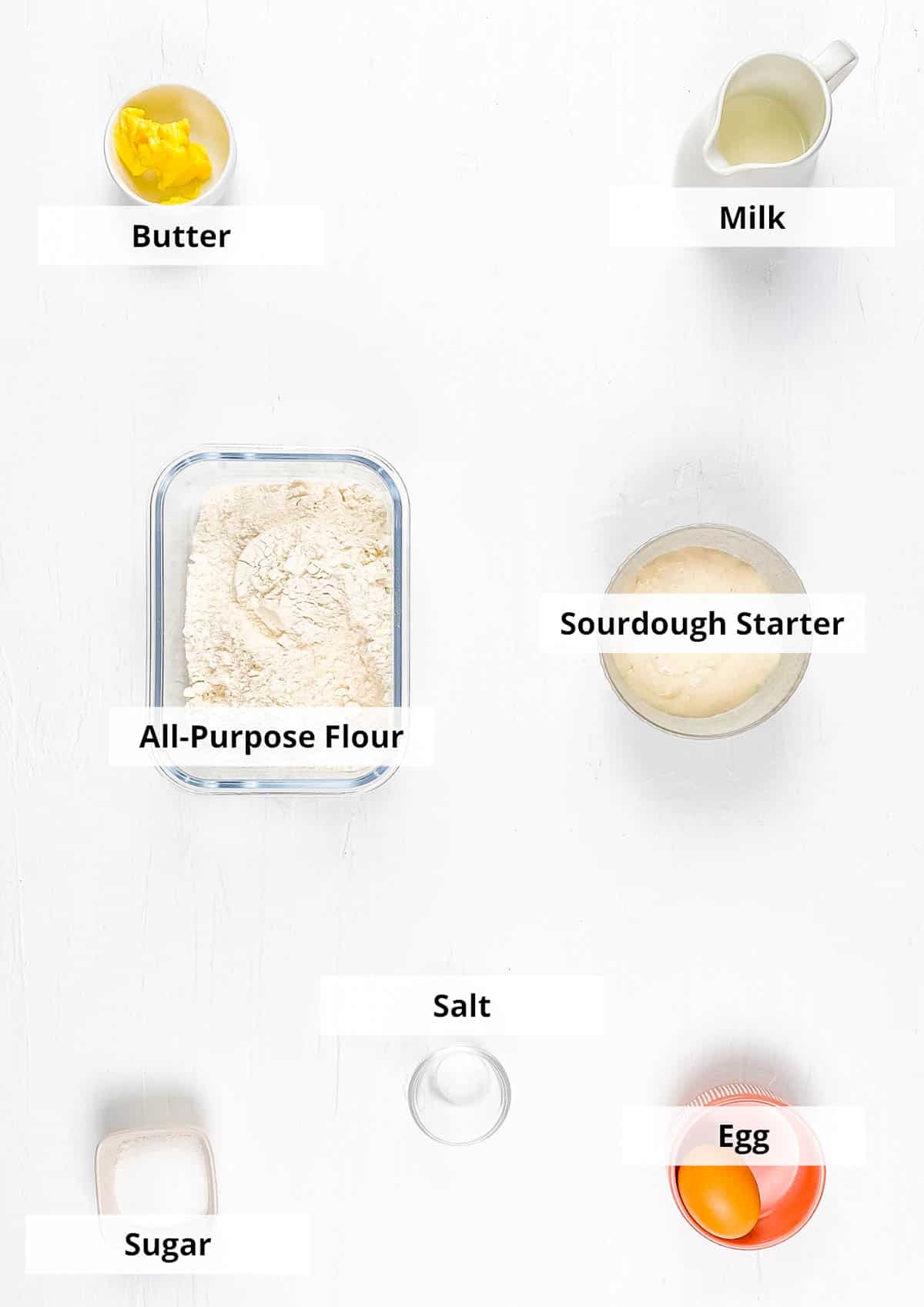
- Active Starter: You want a very active sourdough starter for this recipe to work. This replaces the yeast that is common in a bakery croissant recipe, and helps the croissants rise! Croissants with sourdough starter have a delicious tangy flavor, that you know and love from sourdough bread.
- All-Purpose Flour: This recipe calls for all-purpose flour which will give the croissants a fluffy and chewy texture. You can also use pastry flour for a more delicate croissant.
- Salt & Sugar: These staple ingredients are very common in pastry and sweet bread recipes. The sugar adds the perfect sweetness, while the salt enhances all the natural flavors of sourdough. This croissant recipe calls for 2.96 g salt and 31.25 g sugar.
- Milk: The milk will add more richness to the croissant with a perfect balance of softness and flakiness.
- Butter: This easy sourdough croissants recipe calls for a lot of butter! You will use butter in the dough mix, along with using a butter package to help with laminating dough for croissants. If you have been wondering how to make a flaky croissant, it is the thin layers of folded butter and dough that do the trick!
- Egg: Egg is used for an egg wash. You can use the whole egg or just the egg yolk for this recipe. Whisk and coat the croissants for a beautiful shiny golden brown top!
🔪 Instructions
Homemade sourdough croissants might sound intimidating, but when you break it down step by step it is very doable! It does take a little time and patience, but with practice, you’ll soon become a total expert. Here is how to make sourdough croissants:
Preparing The Dough
Knead The Dough: Add all dough ingredients into the bowl of a stand mixer with a dough whisk or dough hook attachment. Knead until a soft, sticky dough has formed. Scrape the sides of the bowl if needed. Remove the dough and shape into a ball.
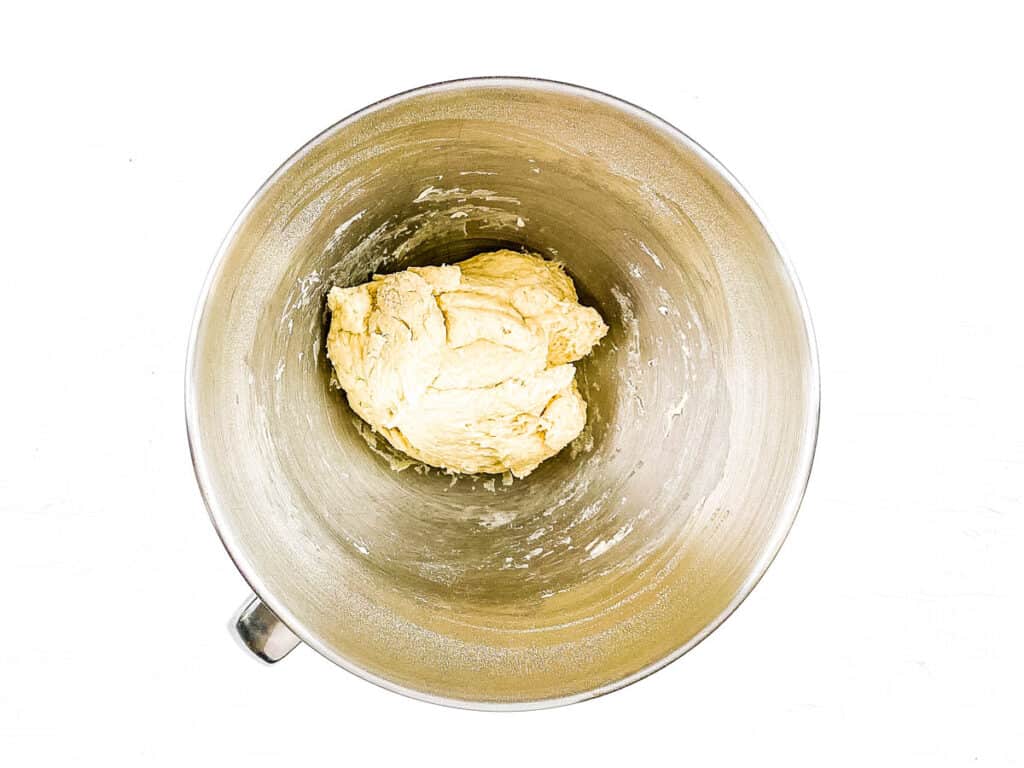
Rest For 1 Hour: Transfer the dough to a lightly greased bowl, cover with plastic wrap and rest for 1 hour at room temperature.
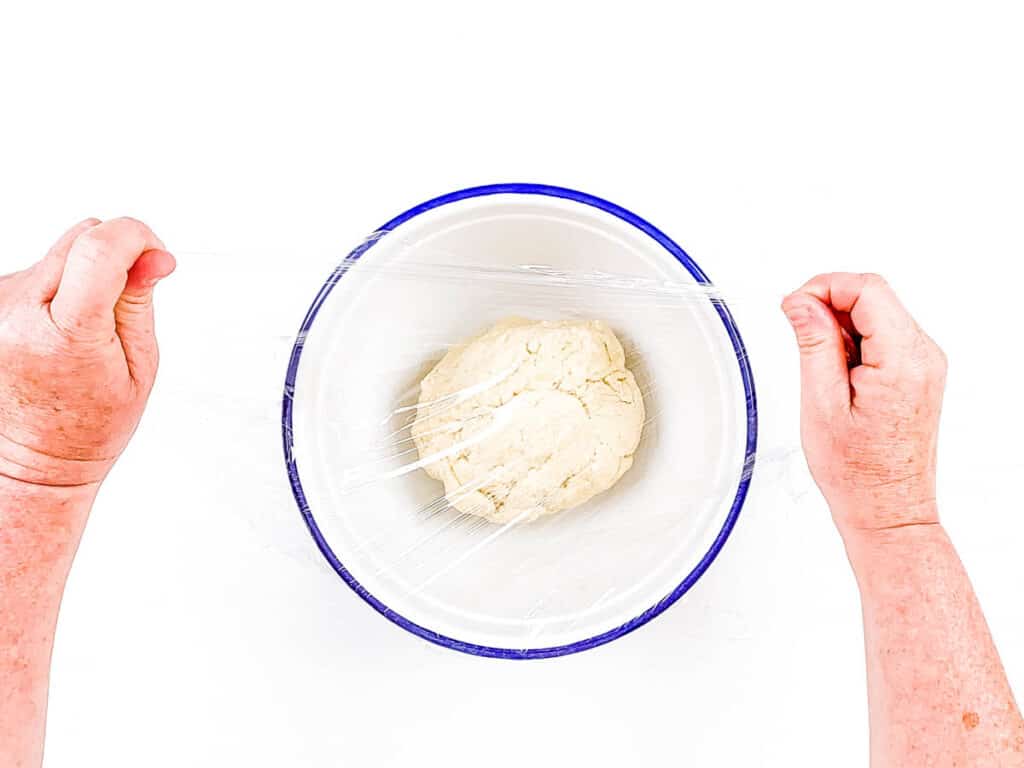
Fold The Dough: After the hour, place the dough onto an un-floured surface and gently press it into a circle. Take one edge and fold it over into the center, turn the dough a quarter turn and repeat. Continue to fold the edges into the middle of the dough until you have worked every edge into the center. Turn the dough over and repeat. Repeat this folding technique 2 more times. The dough will now become very smooth.
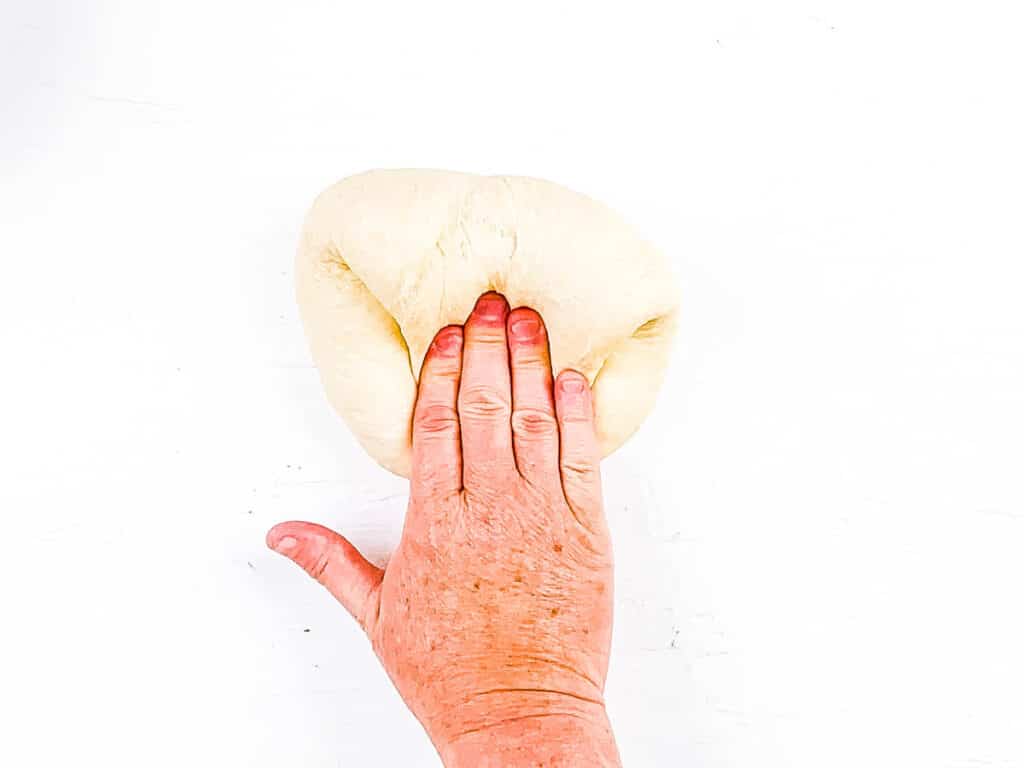
Rest For 3 Hours, Then Chill Overnight: Return the dough to a lightly oiled bowl. Cover and allow the dough to rest at room temperature for another 3 hours. Transfer to the fridge to rest overnight (approximately 12 hours). You can continue the recipe the following morning.
Laminating
Prepare Butter For Lamination: The next morning prepare the room temperature butter for lamination. Place the softened butter block in the center of sheets of parchment paper. Fold the baking paper to make a 5”x5” square in the center. Fold the edges of the paper to cover the butter.
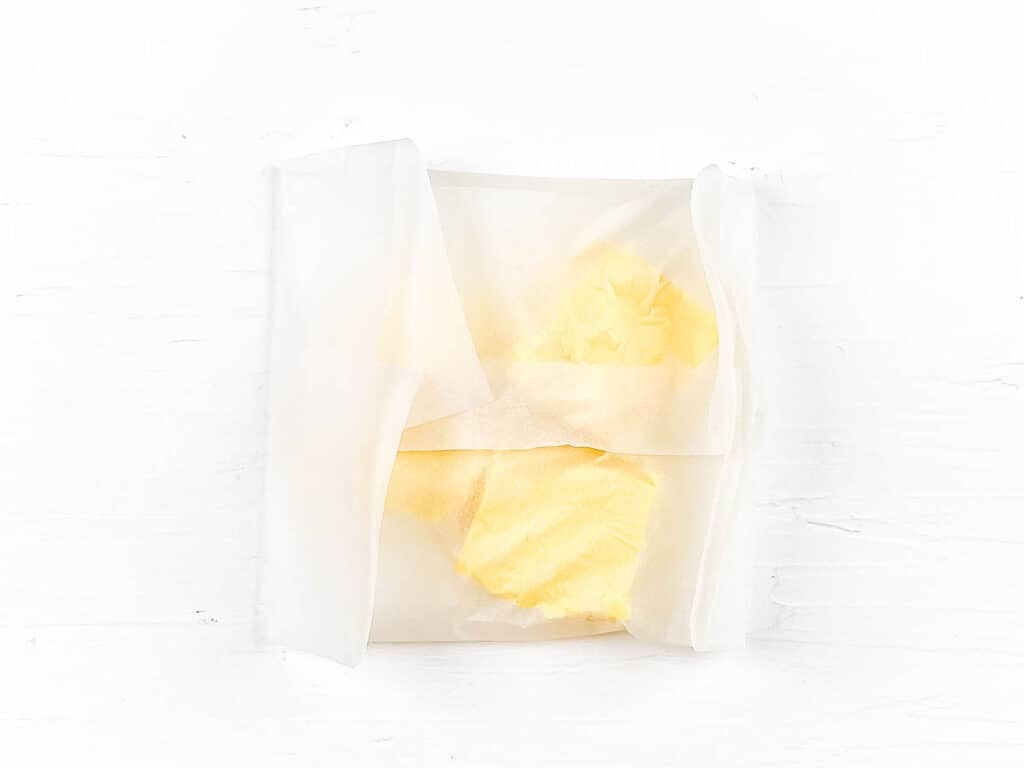
Flatten Butter: Using a rolling pin, flatten the butter to form a square.
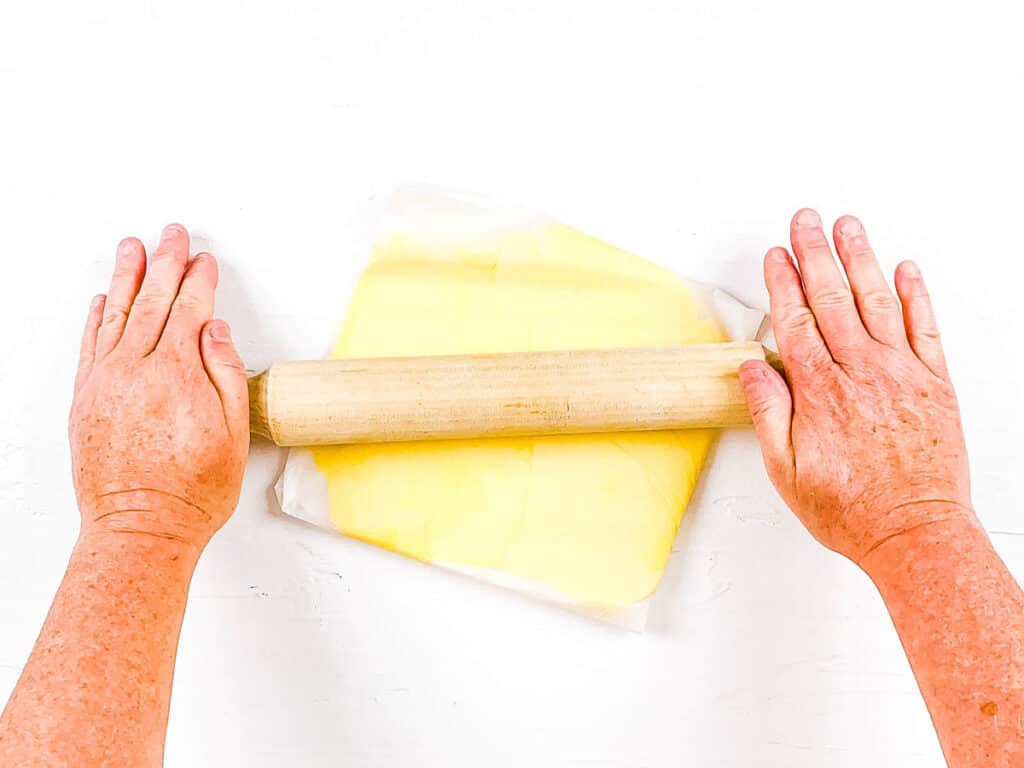
Roll The Dough: Remove the chilled dough from the fridge and allow it to come to room temperature. On a lightly floured surface roll the dough. Ensure the work surface is large enough to encase the butter square.
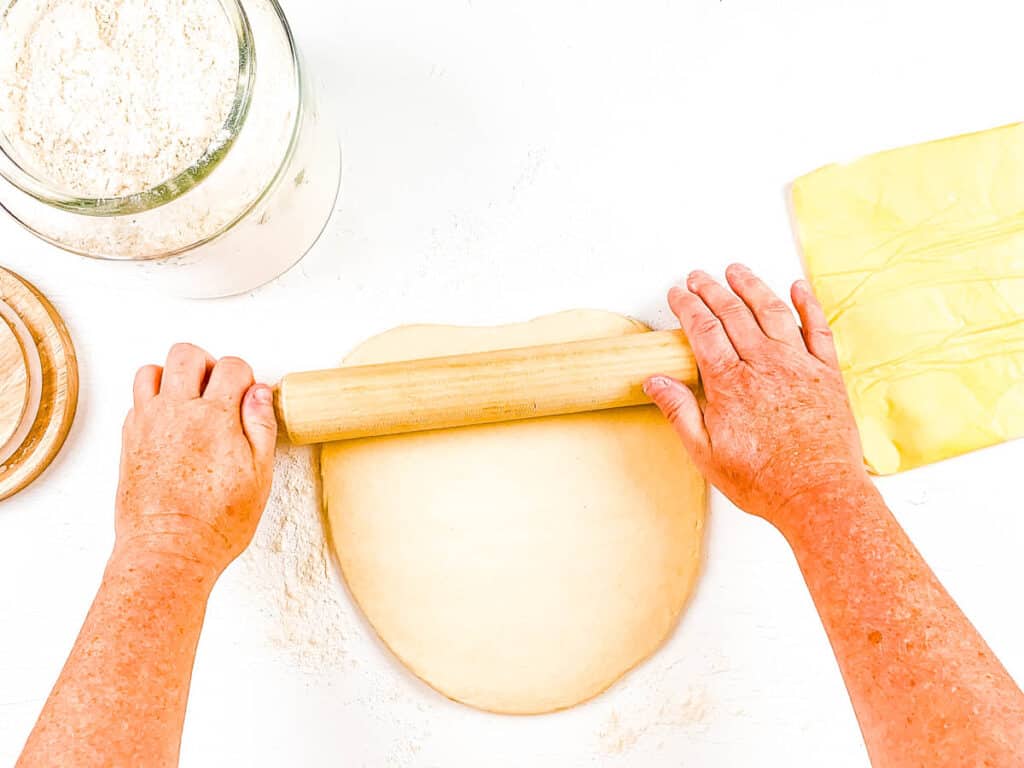
Enclose The Butter: Unwrap the butter and place it into the center of the dough, removing the baking paper.
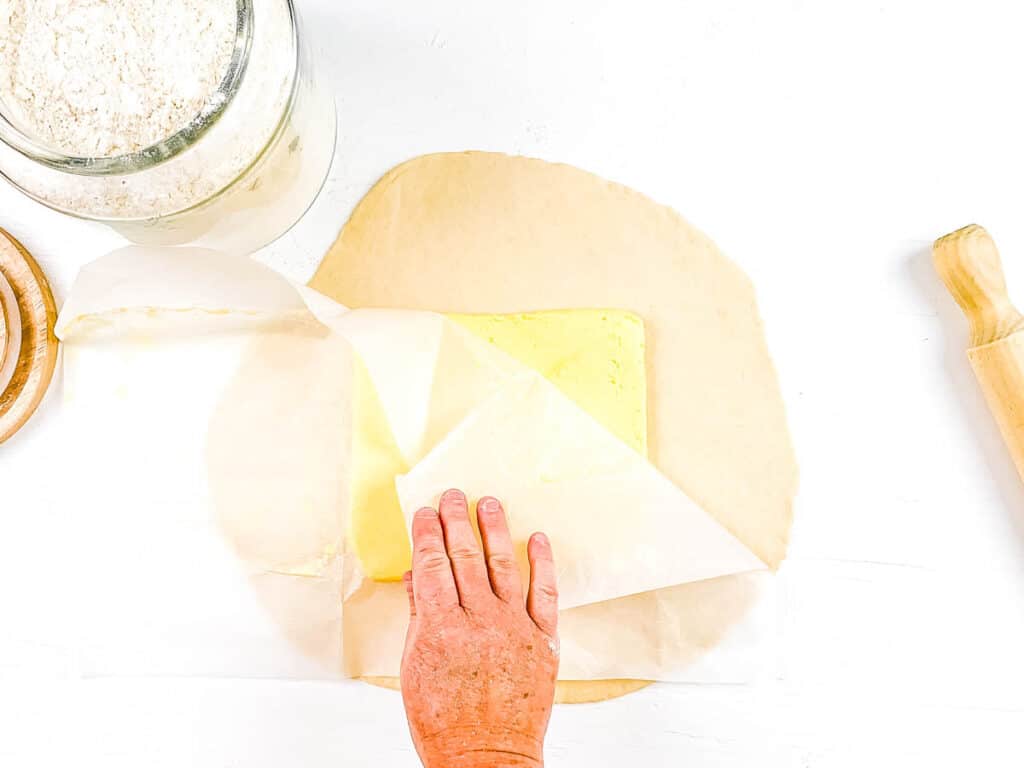
Fold each corner of the dough over to enclose the butter, press to seal the edges so no butter can escape.
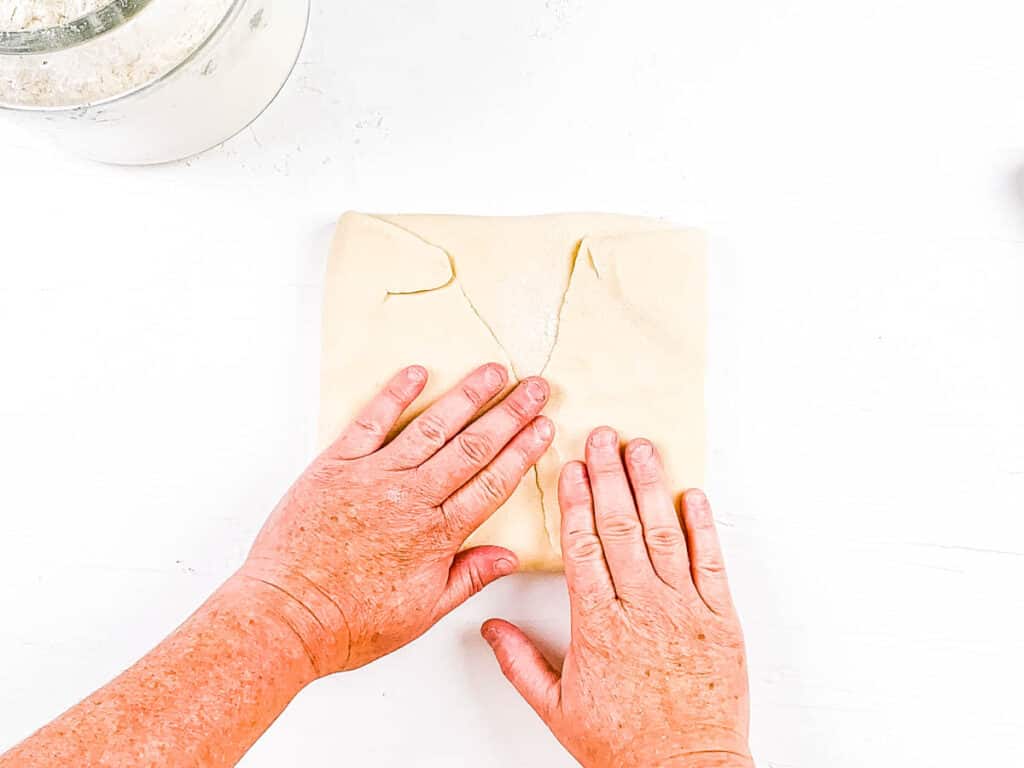
Roll Out The Dough: Turn the dough over and roll into a long rectangle, focusing more on length than width.
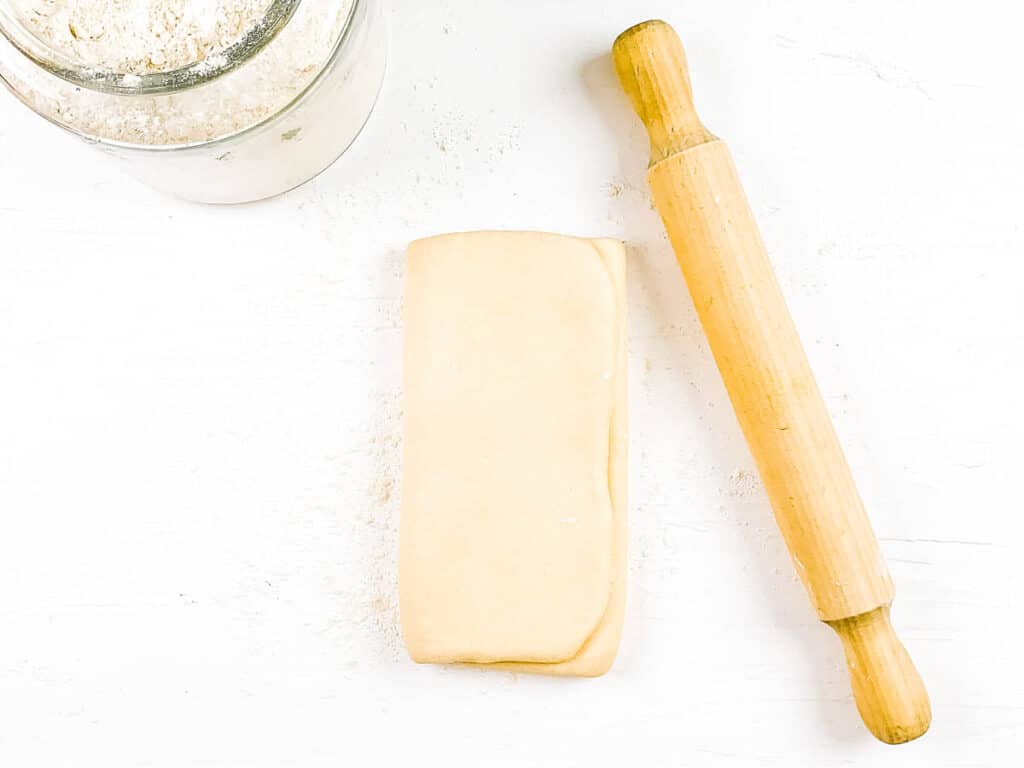
Fold And Cover: Fold the dough into three equal parts by taking the top edge and folding into the center and then covering it with the bottom third of dough, like you’re folding a letter. Cover in plastic wrap and chill in the fridge for 30 minutes.
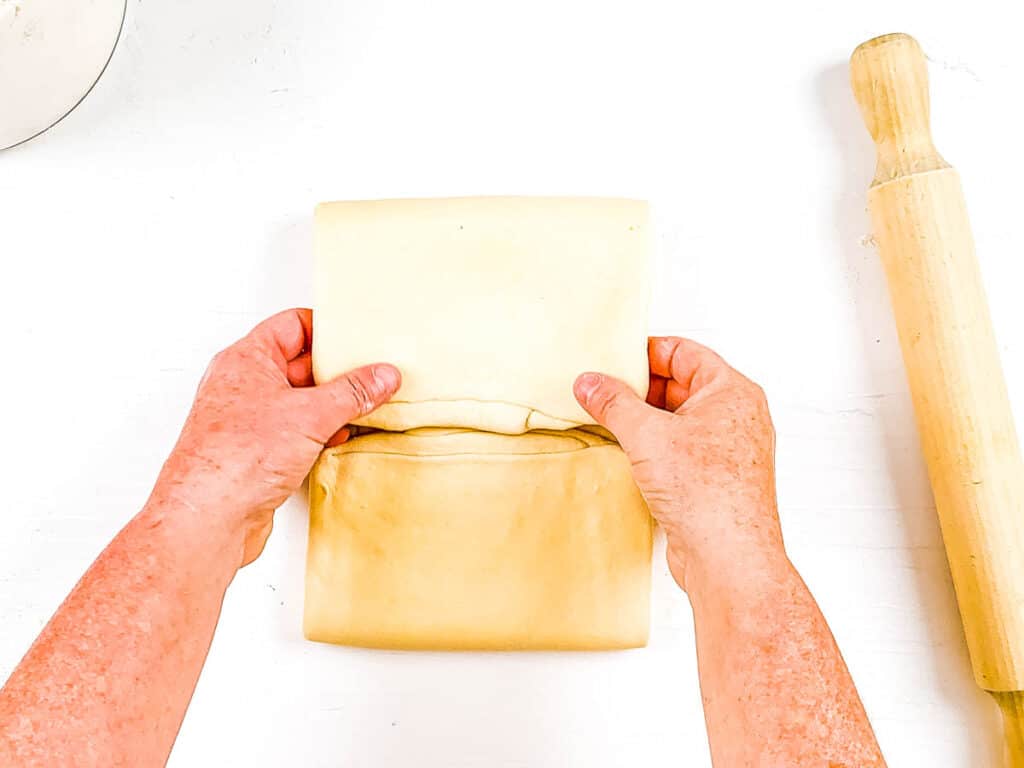
Roll And Fold Again: Remove the plastic wrap, place the dough with the shortest edge facing you and roll into a 20”x6” rectangle. Fold the bottom edge into the center, next fold the top edge into the center and then fold the dough in half like you’re closing a book. Cover and let dough rest in the fridge for 30 minutes.
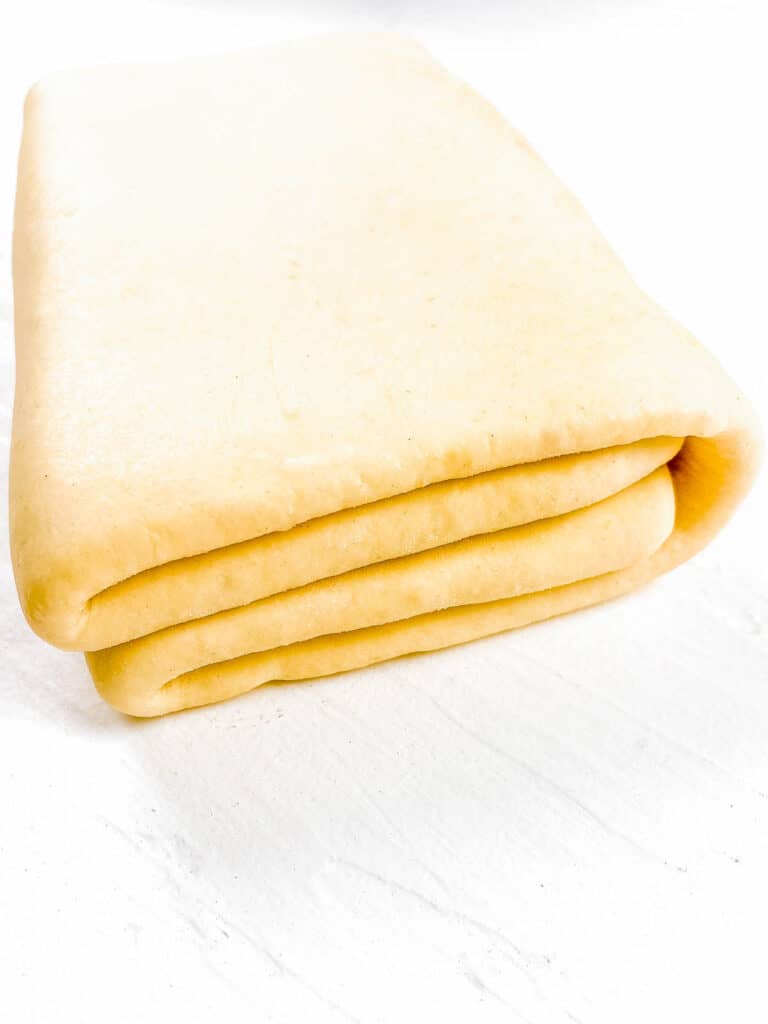
Repeat: Repeat this rolling and folding process 2 more times, making sure to have the smallest edge facing you each time and to chill in between each roll. This repetition allows for lots of flaky layers.
Shaping Croissants And Baking
Roll The Dough: After the cold dough has been rolled and folded 4 times, roll the laminated dough one more time, on a lightly floured work surface, into a 16”x10” rectangle.
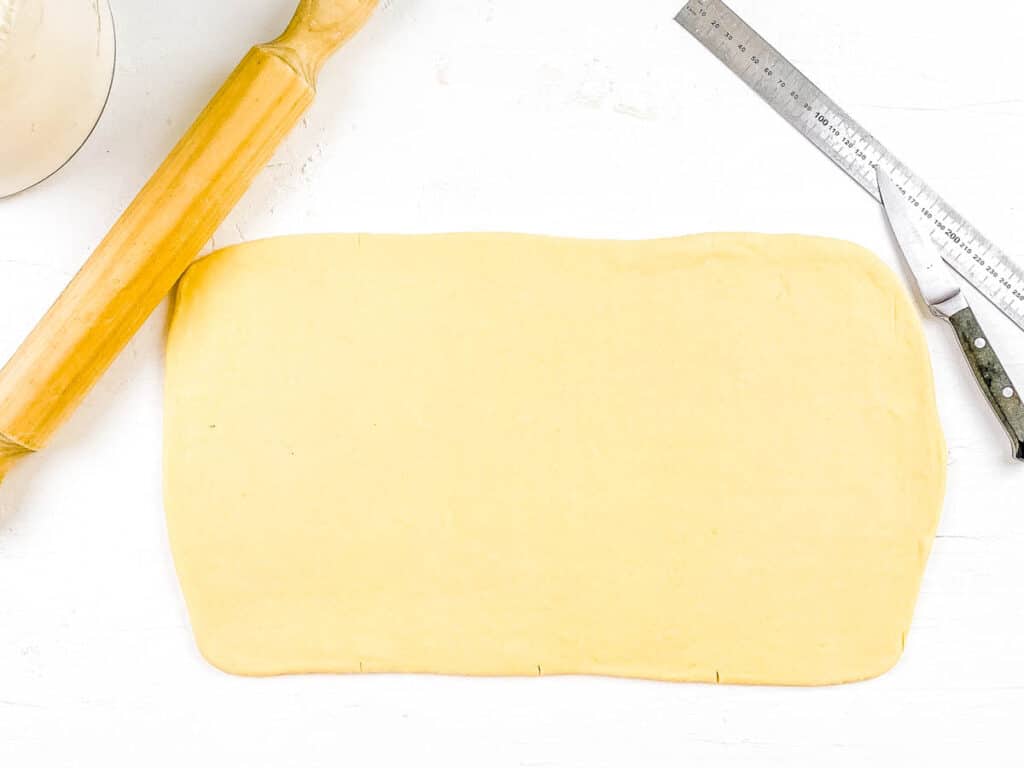
Measure, And Form Triangles: Measure and mark every 4” along the top and bottom of the dough, trim off the side edges for neater croissants. Using a pizza cutter or sharp knife cut from the first mark on the bottom edge to the top left corner, forming a long triangle. Next cut a straight line from the same mark on the bottom to the corresponding mark on the top forming a second triangle. Repeat this process at each mark along the dough until you have 8 dough triangles.
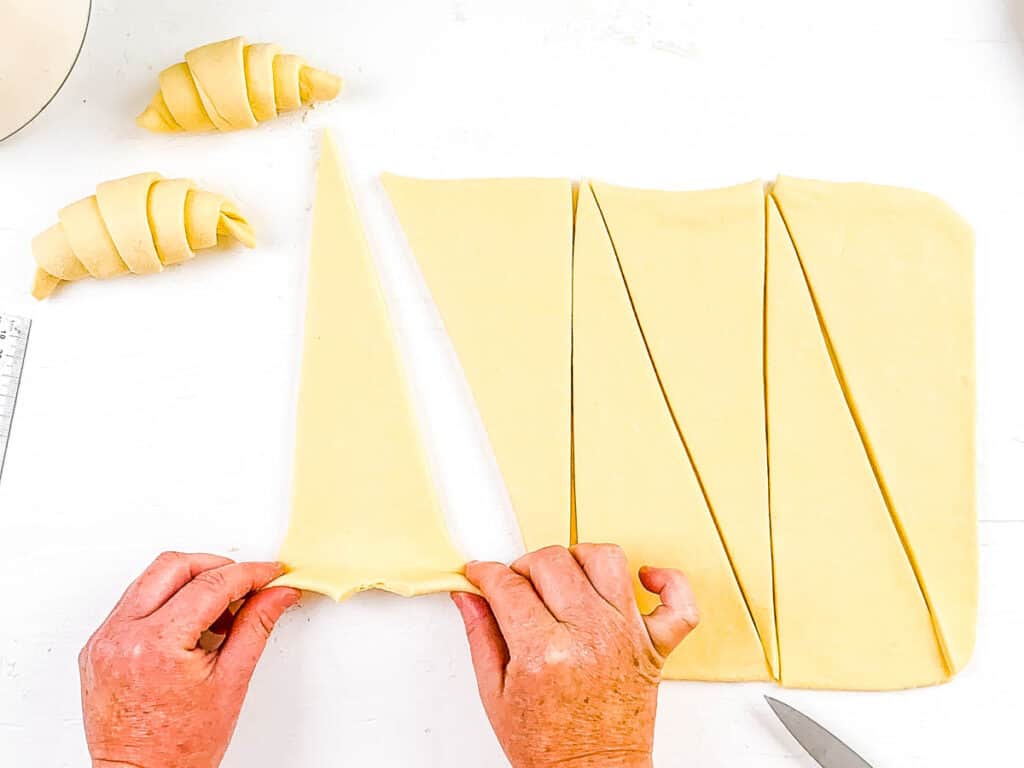
Shape The Croissants: To shape the sourdough crescent rolls, make a small incision at the base of the triangle and gently stretch the dough outwards. Roll the dough tightly towards the tip of the triangle. Repeat this shaping technique until all 8 croissants have been shaped. You can also form a crescent shape.
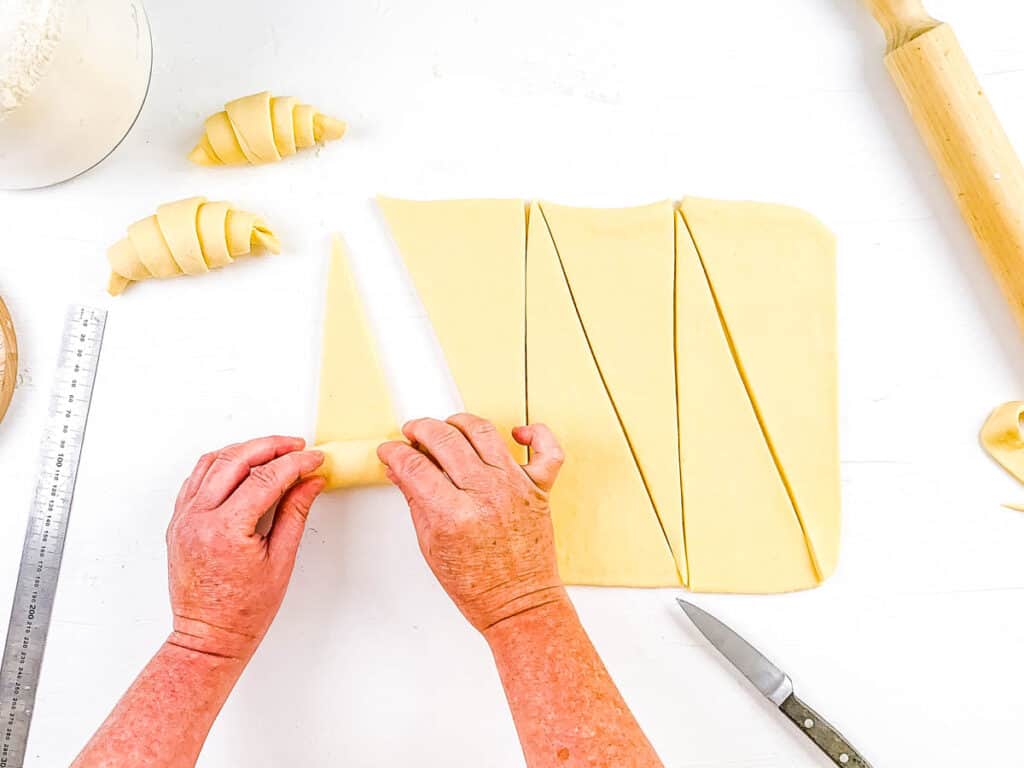
Proof For 3 Hours: Place the shaped dough onto the prepared baking sheets allowing a lot of space for the croissants to rise. Lightly cover the trays with plastic wrap and rest them in a warm place to rise for 3 hours.

The croissants will double from the original size and will be soft and jiggly when touched. You have the option to continue and cook them or place them in the fridge for 1 hour before baking. Chilling helps to retain the shape but is completely optional.

Preheat The Oven & Bake: Preheat the oven to 375 degrees F / 190 C. Line 2 trays with parchment paper and set aside. Gently brush the tops of each sourdough croissant with the egg wash and bake in the preheated oven for 25-30 minutes until golden brown.
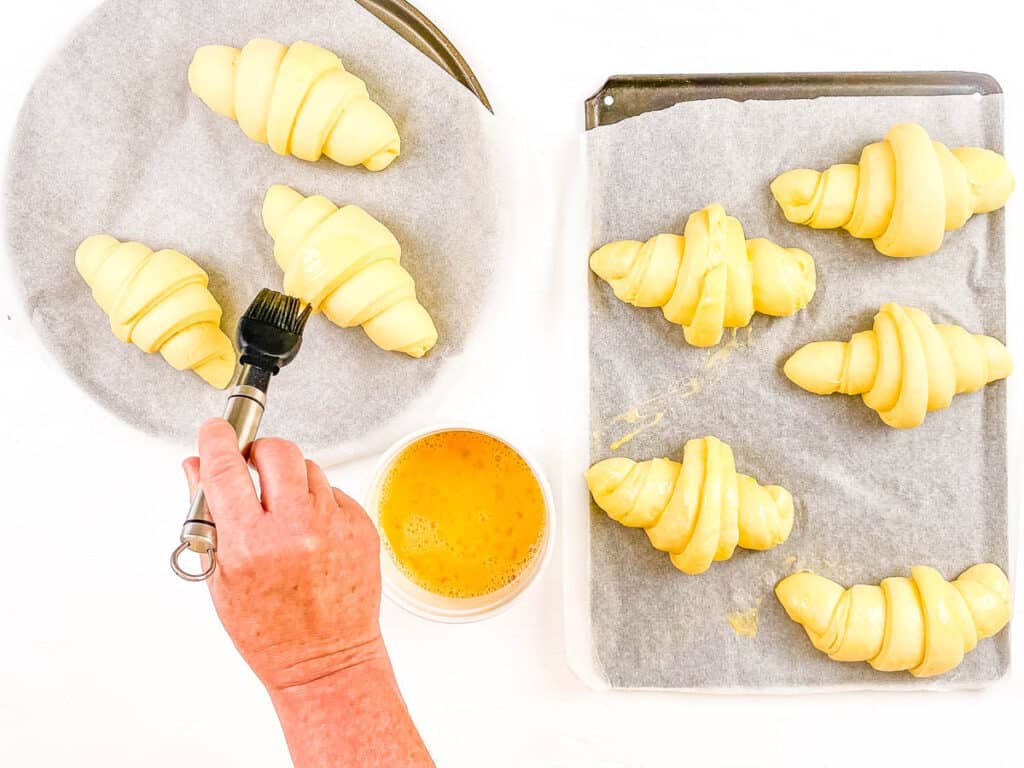
Cool: Remove from the oven and allow to cool completely on the baking trays before serving.

Serve: These sourdough discard croissants are best served the day they’re made!

💭 Expert Tips
- Test your sourdough starter first. The sourdough starter should be very active to provide a great rise from your croissant dough. To test if the starter is active enough, place a spoon full of starter into a bowl of water. If it’s ready to use it should float, if it doesn’t the starter isn’t ready and will need to be fed again. You’ll need to wait until it’s active before using it to make the dough.
- Ensure the dough and butter are a similar consistency when starting the lamination process. Avoid having the dough too cold as it will tear when you roll it out, it needs to be room temperature. Avoid using cold butter as it will shatter when rolled out which will affect the layers when cooked. Ensure it is pliable and at room temperature.
- Roll the dough tightly. When rolling the dough into croissant shape make sure to roll up nice and tight. If you want, you can form crescent rolls.
- Keep your room cool. It’s best to make these sourdough croissants in a room that isn’t too hot. If your room becomes warmer than 77 degrees F / 25 C you may find the butter starts to melt too quickly and won’t laminate correctly.
- Chill after each roll and fold. It’s important to let the butter cool so that it doesn’t get too warm when rolling the dough. It also allows the dough to rest and not overwork the gluten in the dough which would produce a tougher pastry and would make it harder to roll out. This might make the process feel like a long time, but it is so worth it!
- You can make smaller croissants. This recipe makes 8 large croissants, however if you’d prefer smaller croissants you can mark the dough every 2” in step 15 which will produce 16 smaller croissants. The procedure for making them remains the same.
- Use high-fat butter. Using a European or high fat butter will add more flavor and make the lamination process easier.
✔️ Detailed Croissant Troubleshooting Tips
When making sourdough croissants for the first time, you may run into some setbacks or errors. These are my top tips to make sure you end up with the best sourdough croissants!
How To Fix Croissant Dough That Is Too Sticky
If your croissant dough is too sticky, you may be using a butter that is too low in fat. You want to use butter that has a high fat content and low water content. Additionally, your dough may be too warm. It is important to chill the dough in between each fold and roll, which will help it firm up and be easier to work with. If dough is still too sticky, you may need to add 1 to 2 tbsp of flour.
How To Fix Croissants That Are Not Airy
Your croissants will come out more bread-like and less airy if you are not mindful of the temperatures when making your dough. It is best to have both the dough and the butter at room temperature during the lamination process so that the dough does not tear and the butter does not shatter. Too warm of butter will cause the dough layers to stick together, and too cold of butter will break and leave you with an in-cohesive layer structure.
How To Fix Dough That Won’t Roll Out
When rolling your dough, the gluten can get overworked and you’ll have stiff dough that is difficult to roll out and work with. You want to allow the dough time to rest and relax so that it does not get too tough. Cover with plastic and chill in the fridge for 30 minutes. When you take the dough out, it should be easier to roll out!
What To Do If Croissants Won’t Rise
If your sourdough croissants are not rising, it is likely that you did not proof the dough long enough. Next time, be sure to allow plenty of time for proofing. Proof the dough in between folds and overnight in the fridge. Your final proofing will be after the croissants are shaped, in which you want to give them at least 3 hours to double in size. If you had set them in an area that is cooler to proof, you may need to find a better place. You can set them near a warm, sunny window or in a turned-off oven with the lights on. Monitor closely for optimal temperatures.
📖 Variations
- Sourdough Chocolate Croissants: Add a layer of chocolate while you’re rolling your croissant dough for a delicious pain au chocolat! I highly recommend using my vegan nutella!
- Almond Croissants: Try these homemade croissants with added almond extract or a layer of almond paste. You can top with some sliced almonds, as well!
- Sourdough Croissant Breakfast Sandwich: Add on your favorite sandwich fillings like egg, spinach, cheese, and tomato! You will have a tasty and healthy breakfast that will keep you full for hours.
- Cheesy Garlic Croissant: Fill your sourdough croissant with a buttery garlic mixture, pinch of salt, and melted cheese for the ultimate savory treat.
- Vegan Sourdough Croissants: For a vegan option, substitute the milk for any plant based milk, and the butter for a good quality vegan butter. For the egg wash, use plant based milk instead (which you can whisk together with an optional tbsp of maple syrup for more shine).
❓Recipe FAQs
If you have been curious about the health benefits of a sourdough croissant vs normal croissant, there are a few things that stand out!
Sourdough croissants do not use any commercial yeast and instead use only the natural yeast produced in the fermentation process of the sourdough starter. Due to this fermentation process, you also get a lot more health benefits compared to regular croissants.
The sourdough is more easily digested, feeds good bacteria in the gut, and contains more vitamins and minerals than traditional croissants.
For best results, you will keep your dough in the fridge for 12 hours or overnight before beginning the laminating process. You will then chill for 30 minutes after each roll and fold step.
Most croissants use a commercial yeast, but for this sourdough croissant recipe all you need is the active starter. Making your starter is very simple but does take some time. The whole procedure will take about five full days.
Day 1: You will need equal weights of flour and water. A good place to start is with 113 g flour and 113 g water. Stir well with a wooden spoon so that no excess flour is left unmixed. Cover loosely and let sit at room temperature overnight.
Day 2: The next day you may start to see a bit of growth in your starter. Discard 113 g starter and feed the rest with a fresh 113 g flour and 113 g water. Use cold water if your home is warm. Cover and rest again for 24 hours.
Day 3-5: By day 3 you will keep 113 g sourdough starter and discard the rest. Again add 113 g water and flour. Mix, cover, and rest for 12 hours. Repeat every 12 hours for day 4 and 5.
You will know your starter is ready when it is risen and very bubbly.
Yes! You can freeze either the croissant dough or the baked croissants. See the full instructions for how to properly freeze and store below.
To Store In The Fridge: These buttery sourdough croissants can be stored in an airtight container in a cool dry place for up to 2 days.
To Freeze: You can freeze these croissants either baked or unbaked. If freezing before baking, follow the instructions until step 20. After the croissants have fully risen, lightly cover the tray in cling film and place in the freezer for at least 2 hours before transferring them to a zip lock plastic bag to freeze for up to 2 months. If freezing cooked croissants, place them in a ziplock bag and freeze for up to 2 months.
To reheat, allow the sourdough croissants to thaw completely before placing into a preheated oven at 338F/170C for 5 minutes to become crispy.
Sourdough bread is healthier than most breads due to its simple ingredients and fermentation process. Sourdough makes a great prebiotic to feed the healthy bacteria in our body and is easier to digest since the proteins and fiber have already been partially broken down. Sourdough has less gluten than other breads, and won’t spike your blood sugar as much!

🍲 More Delicious Bakery & Sourdough Recipes!
- Blueberry Sourdough Muffins
- Sourdough Discard Pancakes
- Blueberry Banana Bread
- Buckwheat Sourdough Bread
- Green Waffles
- Croffles
- Strawberry Donuts
- Mini Apple Pies With Puff Pastry
- Healthy Vegan Strawberry Pop Tarts
- Vegan Bagel Recipe
- Gluten Free Focaccia Bread
Want to Save This Recipe?
Enter your email & I’ll send it to your inbox. Plus, get great new recipes from me every week!
By submitting this form, you consent to receive emails from The Picky Eater.
Love this Plant based breakfast recipe? Please leave a 5-star rating 🌟 in the recipe below and/or a review in the comments section further down the page!
You can also FOLLOW ME on FACEBOOK, TWITTER, INSTAGRAM, and PINTEREST to see more delicious, healthy, family-friendly food, and if you have any questions, I’m here to help!
📋 Recipe Card
🎥 Watch How to Make It
Sourdough Croissants
Ingredients
Dough Ingredients
- ½ cup active sourdough starter
- 1⅔ cup all-purpose flour
- ½ tsp salt
- 2½ tbsp sugar
- ½ cup milk
- 2½ tbsp butter room temperature
Butter Block For Lamination
- 8 oz butter softened
Glaze
- 1 egg whisked
Equipment
Instructions
Preparing The Dough
- Add all dough ingredients into the bowl of a stand mixer and knead until a soft, sticky dough has formed.
- Remove the dough and shape into a ball.
- Transfer the dough to a lightly oiled bowl, cover with plastic wrap and rest for 1 hour at room temperature.
- After the hour, place the dough onto a bench and gently press it into a circle. Take one edge and fold it over into the center, turn the dough a quarter turn and repeat. Continue to fold the edges into the centre until you have worked every edge into the center. Turn the dough over and repeat.
- Repeat this folding technique 2 more times. The dough will now become very smooth.
- Return the dough to a lightly oiled bowl. Cover and allow the dough to rest at room temperature for another 3 hours.
- Transfer to the fridge to rest overnight (approximately 12 hours).
Laminating
- The next morning prepare the room temperature butter for lamination.
- Place the softened butter in the center of a sheet of baking paper. Fold the baking paper to make a 5”x5” square in the center. Fold the edges of the paper to cover the butter.
- Using a rolling pin, flatten the butter to form a square.
- Remove the dough from the fridge and allow it to come to room temperature.
- Roll the dough on a lightly floured bench large enough to encase the butter square.
- Unwrap the butter and place it into the center of the dough, removing the baking paper.
- Fold the edges of the dough over to enclose the butter, press to seal the edges so no butter can escape.
- Turn the dough over and roll into a 20”x6” rectangle, focusing more on length than width.
- Fold the dough into thirds by taking the top edge and folding into the center and then covering it with the bottom third of dough, like you’re folding a letter.
- Cover in plastic wrap and chill in the fridge for 30 minutes.
- Remove the plastic wrap, place the dough with the shortest edge facing you and roll into a 20”x6” rectangle. Fold the bottom edge into the center, next fold the top edge into the center and then fold the dough in half like you’re closing a book.
- Cover and rest in the fridge for 30 minutes.
- Repeat this rolling and folding process 2 more times, making sure to have the smallest edge facing you each time and to chill in between each roll.
Shaping Croissants And Baking
- After the dough has been rolled and folded 4 times roll the dough one more time, on a lightly floured bench, into a 16”x10” rectangle.
- Measure and mark every 4” along the top and bottom edges of the dough, trim off the side edges for neater croissants.
- Using a pizza cutter or sharp knife cut from the first mark on the bottom edge to the top left corner, forming a long triangle. Next cut a straight line from the same mark on the bottom to the corresponding mark on the top forming a second triangle. Repeat this process at each mark along the dough until you have 8 dough triangles.
- To shape the croissants make a small incision at the bass of the triangle and gently stretch the dough outwards. Roll the dough tightly towards the tip of the triangle.
- Repeat this shaping technique until all 8 croissants have been shaped.
- Place the croissants onto the prepared baking trays allowing a lot of space for the croissants to rise.
- Lightly cover the trays with plastic wrap and rest them in a warm place to rise for 3 hours, the croissants will double in size and will be soft and jiggly when touched. You have the option to continue and cook them or place them in the fridge for 1 hour before baking. Chilling helps to retain the shape but is completely optional.
- Preheat the oven to 375 degrees F / 190 C. Line 2 trays with baking paper and set aside.
- Gently brush the tops of each croissant with the whisked egg and bake in the preheated oven for 25-30 minutes until golden.
- Remove from the oven and allow to cool completely on the baking trays before serving. These croissants are best served immediately, on the day they're made.
Notes
- The sourdough starter should be very active to provide a great rise from your dough. To test if the starter is active enough place a spoon full of starter into a bowl of water if it’s ready to use it should float, if it doesn’t the starter isn’t ready and will need to be refed and you’ll need to wait until it’s active before using to make the dough.
- It takes 2 days to complete the entire recipe but it is so worth the wait!
- Ensure the dough and butter are the same consistency when starting the lamination process. Avoid having the dough too cold as it will tear when you roll it out, it needs to be room temperature. Avoid the butter being too cold as it will shatter when rolled out which will effect the layers when cooked, ensure it is pliable and at room temperature.
- When rolling the dough into croissant shape make sure to roll up nice and tight.
- It’s best to make these sourdough croissants in a room that isn’t too hot. If your room becomes warmer than 77F/25C you may find the butter starts to melt too quickly and won’t laminate correctly.
- It’s important that the butter doesn’t get too warm when rolling the dough which is why it’s important to chill after each roll and fold.
- This recipe makes 8 large croissants however if you’d prefer smaller croissants you can mark the dough every 2” in step 15 which will produce 16 smaller croissants. The procedure for making them remains the same.
- Chilling in between each roll and fold allows the dough to rest and not overwork the gluten in the dough which would produce a tougher pastry and would make it harder to roll out.
- Store in an airtight container in a cool dry place for 2 days.
- You can freeze these croissants either baked or unbaked. If freezing before cooking follow the instruction until step 20. After the croissants have fully risen lightly cover the tray in plastic wrap and place in the freezer for at least 2 hours before transferring them to a zip lock bag to freeze for up to 2 months.
- To cook from frozen place them on a baking tray and cook as described in the instructions above.
- If freezing cooked croissants place them in a ziplock bag and freeze for up to 2 months. To reheat allow them to thaw completely before placing into a preheated oven at 338F/170C for 5 minutes to become crispy.


































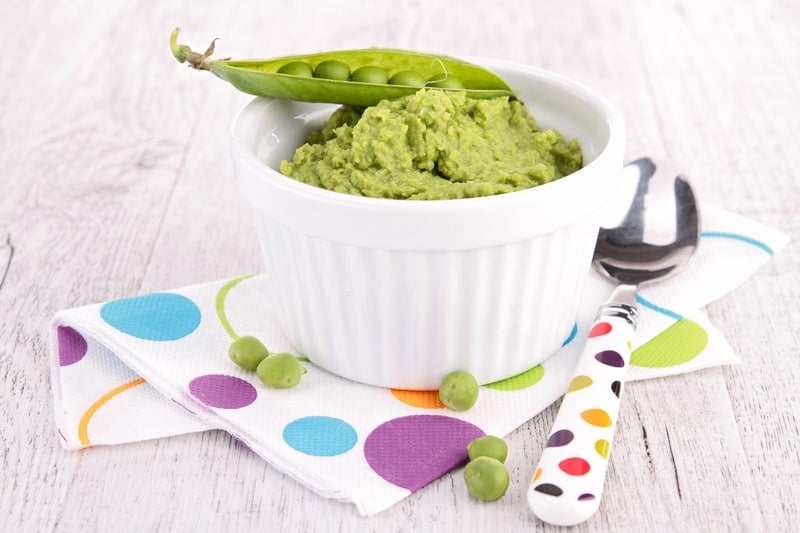



OMG…
Today is Sunday, January 21, 2024, and I started baking sourdough about five months ago, along with many other things that can be made from sourdough and I just pulled these croissants, from this exact recipe, out of my oven and I am literally in shock that they taste better than any croissant from a store or a café I have ever tried.
SO BUTTERY AND FLAKY!
I didn’t have to leave this review because I usually never do but if you’re unsure, you should really try it because this is absolutely the best I’ve ever had!
Thank you to whoever put this recipe out there.
Oh wow! Your comment totally made my day Shaneen!! I’m so so happy to hear that you loved this recipe – I tested it quite a few times to get it just right! 🙂
These croissants were a huge hit in my home. Wow! They came out really fluffy. Liked your tips about sourdough starter.
Thanks so much Rachna! So glad you liked this recipe!
Thanks for this recipe! My whole family is going to love it!
Can’t wait to hear how it turns out for you Lily! 🙂
I have a bunch of sourdough starter in my fridge and now I know exactly what to do with it! Can’t wait to make these croissants, they look absolutely lovely.
Yes!! You will love this recipe Natalie! 🙂
Super fluffy, a hit even when baking with the kiddos.
Thank you so much Sarah! 🙂
I have officially been spoiled! Those were the best croissants ever! I no longer want any others. Thank you for this awesome recipe!
Aw yay! I’m so happy to hear that Ned!